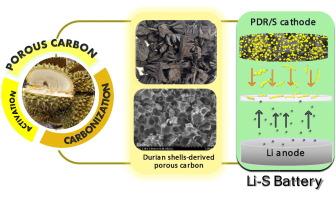可持续硫宿主来自榴莲壳衍生的多孔碳,用于增强锂硫电池的循环稳定性
IF 5.1
3区 材料科学
Q2 MATERIALS SCIENCE, COATINGS & FILMS
引用次数: 0
摘要
本研究研究了从废榴莲壳中提取的多孔碳对电化学锂硫电池性能的影响。采用两种不同的制备方法合成多孔碳:一步氢氧化钾活化水热碳化(PDRH)和两步生物炭活化后碳化(PDRB)。采用BET、SEM、TEM、XRD、Raman和TGA等手段对合成的多孔碳进行了表征,并对其化学和物理性质进行了表征。尽管两种样品的表面积相似,但其孔隙体积和孔径分布却不同。PDR-B在活化后主要表现为2-30 nm的介孔,而PDR-H则表现为1.5-8 nm的微/介孔组合。采用熔融扩散法制备了硫碳质量比为7:3的PDR/S复合材料。电化学性能测试表明,PDR-H/S复合材料具有优异的循环稳定性,在0.2C下循环400次后仍能保持50%的容量,在0.1C下的放电容量为583.7 mAhg−1,高于PDR-B/S复合材料的477 mAhg−1。PDR-H/S的长期循环稳定性的提高是由于其不同的孔隙结构(微孔/中孔)中有更好的硫约束。PDR-H中存在的微孔/中孔似乎更有效地限制硫,从而导致更好的电池性能。此外,该研究还强调,除了表面积和孔隙体积外,孔径分布对PDR/S复合材料的电化学性能起着至关重要的作用。本文章由计算机程序翻译,如有差异,请以英文原文为准。

Sustainable sulfur hosts from durian shells-derived porous carbon for enhanced cycling stability in lithium‑sulfur batteries
This study investigates the impact of porous carbon derived from waste durian shells on the performance of electrochemical lithium‑sulfur (Li![]() S) batteries. Two different preparation methods were employed to synthesize porous carbon: a one-step KOH activation via hydrothermal carbonization (PDR
S) batteries. Two different preparation methods were employed to synthesize porous carbon: a one-step KOH activation via hydrothermal carbonization (PDR![]() H) and a two-step process involving biochar activation followed by carbonization (PDR
H) and a two-step process involving biochar activation followed by carbonization (PDR![]() B). The synthesized porous carbons were characterized using BET, SEM, TEM, XRD, Raman, and TGA to determine their chemical and physical properties. Despite similar surface areas, the two samples exhibited different pore volumes and pore size distributions. PDR-B primarily displayed mesopores (2–30 nm) after activation, whereas PDR-H showed a combination of micro/mesopores (1.5–8 nm). PDR/S composites were prepared by melt-diffusion method with a 7:3 mass ratio of sulfur to carbon. Electrochemical performance testing indicated that the PDR-H/S composite exhibited superior cycling stability, retaining 50 % of its capacity after 400 cycles at 0.2C, and delivered a higher discharge capacity of 583.7 mAhg−1 at 0.1C compared to the PDR-B/S composite, which achieved 477 mAhg−1.The improved long-term cycling stability of PDR-H/S is attributed to better sulfur confinement within its varied pore structure (micro/mesopores). The presence micro/mesopores in PDR-H appears to be more effective for sulfur confinement and thus leads to better battery performance. Additionally, the study highlights that, beyond surface area and pore volume, the pore size distribution plays a crucial role in determining the electrochemical performance of the PDR/S composites.
B). The synthesized porous carbons were characterized using BET, SEM, TEM, XRD, Raman, and TGA to determine their chemical and physical properties. Despite similar surface areas, the two samples exhibited different pore volumes and pore size distributions. PDR-B primarily displayed mesopores (2–30 nm) after activation, whereas PDR-H showed a combination of micro/mesopores (1.5–8 nm). PDR/S composites were prepared by melt-diffusion method with a 7:3 mass ratio of sulfur to carbon. Electrochemical performance testing indicated that the PDR-H/S composite exhibited superior cycling stability, retaining 50 % of its capacity after 400 cycles at 0.2C, and delivered a higher discharge capacity of 583.7 mAhg−1 at 0.1C compared to the PDR-B/S composite, which achieved 477 mAhg−1.The improved long-term cycling stability of PDR-H/S is attributed to better sulfur confinement within its varied pore structure (micro/mesopores). The presence micro/mesopores in PDR-H appears to be more effective for sulfur confinement and thus leads to better battery performance. Additionally, the study highlights that, beyond surface area and pore volume, the pore size distribution plays a crucial role in determining the electrochemical performance of the PDR/S composites.
求助全文
通过发布文献求助,成功后即可免费获取论文全文。
去求助
来源期刊

Diamond and Related Materials
工程技术-材料科学:综合
CiteScore
6.00
自引率
14.60%
发文量
702
审稿时长
2.1 months
期刊介绍:
DRM is a leading international journal that publishes new fundamental and applied research on all forms of diamond, the integration of diamond with other advanced materials and development of technologies exploiting diamond. The synthesis, characterization and processing of single crystal diamond, polycrystalline films, nanodiamond powders and heterostructures with other advanced materials are encouraged topics for technical and review articles. In addition to diamond, the journal publishes manuscripts on the synthesis, characterization and application of other related materials including diamond-like carbons, carbon nanotubes, graphene, and boron and carbon nitrides. Articles are sought on the chemical functionalization of diamond and related materials as well as their use in electrochemistry, energy storage and conversion, chemical and biological sensing, imaging, thermal management, photonic and quantum applications, electron emission and electronic devices.
The International Conference on Diamond and Carbon Materials has evolved into the largest and most well attended forum in the field of diamond, providing a forum to showcase the latest results in the science and technology of diamond and other carbon materials such as carbon nanotubes, graphene, and diamond-like carbon. Run annually in association with Diamond and Related Materials the conference provides junior and established researchers the opportunity to exchange the latest results ranging from fundamental physical and chemical concepts to applied research focusing on the next generation carbon-based devices.
 求助内容:
求助内容: 应助结果提醒方式:
应助结果提醒方式:


